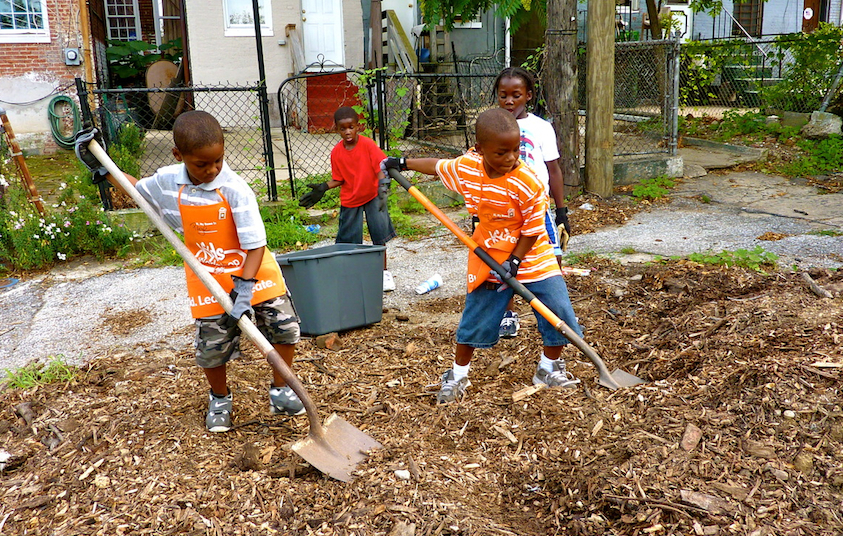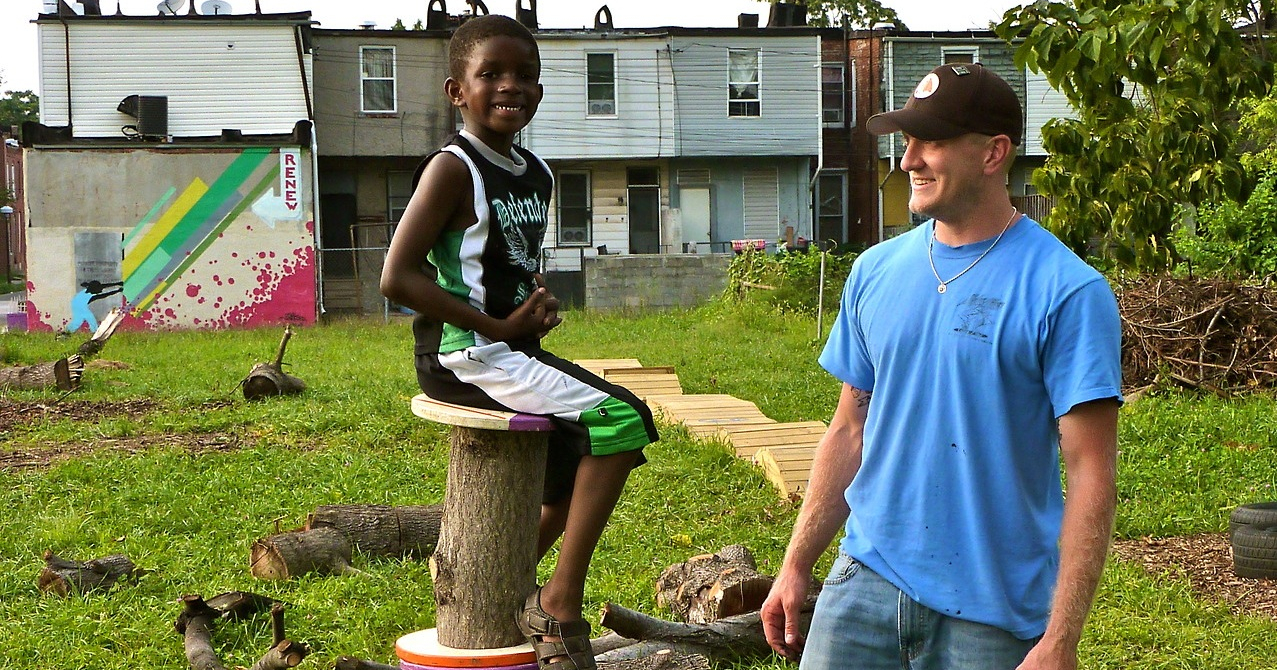Less than three years ago, the Oliver neighborhood of East Baltimore looked almost post-apocalyptic. Vacant row houses with burnt-out roofs and boarded windows lined entire blocks, and mounds of trash sat in empty and overgrown lots where kids once gathered to play. Most signs of life were at dimly lit liquor stores or in dark alleys where cocaine and heroin were bought and sold.
Over the last decade, much of the news coming out of Oliver has been centered on poverty, crime, and the mass exodus of its residents to other areas of the city. More recently, however, the stories are about revitalization and hope.
The 6th Branch, a veteran-led community service organization, along with social designer Briony Hynson and a group of passionate residents, have set out to rebuild Oliver.
It started in a big way in October 2011. The 6th Branch launched their Operation Oliver initiative. They immediately mobilized thousands of volunteers, removed 75 tons of garbage and debris, painted three large murals, and planted more than 100 trees and shrubs.
They were able to do this quickly because of the veterans’ “act now” mentality.
“For us, it doesn’t take five meetings to pick up trash in an alley; it takes a trip to the store to pick up some trash bags—and then doing it,” says Dave Landymore, Executive Director of The 6th Branch.
But “a relatively clean neighborhood is not a revitalized neighborhood,” so for Landymore, a 10-year U.S. Marine Corps vet, this was just the beginning.
In the last two years, The 6th Branch started a free community farm stand full of local fruits and vegetables, they’ve helped residents with job retraining and green home construction, and built the Bethel Street Garden and Playscape for the neighborhood kids. This is where they recently hosted their second Cardboard Challenge.
“Though many aspects of the work in Oliver inspire us, we are most drawn to the playscape,” says Mike McGalliard, Executive Director of the Imagination Foundation. “Communities come together through play. And it’s through play that future innovators are born.”
The Play Deficit
The 6th Branch worked with designer Briony Hynson to build the playscape. At the time, she was a social design fellow at The Maryland Institute College of Art (MICA) and her thesis project was to give urban youth in underserved Baltimore communities access to play.
Hynson believes the lack of play space in Baltimore can have a critically damaging affect on the development of the city’s youth— socially, emotionally, physically, and intellectually.
In neighborhoods without a park or playground, childhood obesity rates increase by as much as 29 percent, according to KaBOOM!, a national nonprofit that envisions a great place to play within walking distance of every child. And without ample play, creativity, imagination, curiosity, and other factors critical to a child’s success in school and life will steadily decline.
In East Baltimore “there’s only one playground for every 300 kids. But there’s a vacant lot for every 9.5 kids,” Hynson explains. “We’ve got to shift our priorities and “use our creative energies to figure out how to use these spaces better.”

Neighborhood kids get their hands dirty while constructing the Bethel Street Playscape and Garden. (Photo c/o Briony Hynson)
Reclaiming ‘Murder Alley’
The spot where Hynson, The 6th Branch, and community volunteers constructed their first playscape and garden is in the center of the Oliver neighborhood, in a vacant lot once known as Murder Alley.
The first thing Hynson did was place a tire swing and a tetherball in the lot to see how kids would react. Children who had never before been in this space showed up to play.
“A $20 investment transformed this place from destitute to hopeful,” Hynson told Baltimore Style in a recent interview.
She asked the neighborhood kids what else they wanted in their playscape, and after some coaxing to let their imaginations run wild, they came up with ideas like a place for robots, a zipline, an underground trampoline, and space for dancing.
The playscape was officially completed on June 15, 2013, with space for dancing, basketball, bike ramps, and a giant dinosaur jungle gym named Sparky. While there probably won’t be an underground trampoline in the space, the park continues to evolve and adapt to meet the kids’ needs and interests.
As the playscape was being constructed, a group of boys started playing football in the open lot. This led Hynson to reenvision the final design to include as much space as possible for the team to practice. After a redesign in February 2013, 6th Branch volunteers, along with football players from a local university, came out to coach the kids.
The playscape, Landymore says, “is an area of the neighborhood that we have taken back. It used to be completely overgrown, neglected, abandoned, and now it’s full of color. There’s cut grass in the summer and a landscape for kids to go, enjoy, feel safe and just be kids.”
The attitude of the neighborhood kids has also changed since the playscape was built. “When a local young troublemaker comes along and has had a bad day at school, I give him a shovel and let him shovel some mulch. His mood changes by being involved in something, being helpful at something.”
The Imagination Foundation + Operation Oliver
Hynson says that after seeing Caine’s Arcade and learning about the Imagination Foundation, she knew she and The 6th Branch had to put on the event. They’ve done three now at the Bethel Street Playscape and Garden—the place once known as Murder Alley.
“Whenever I am out in the space, the kids would come up to me and say, ‘when are we going to do another one of those [cardboard challenge] events?’ ” Hynson says.
Volunteers made the events simple: the only expectation was that kids make something out of cardboard. They made robots, arcade games, a community fort, and all kinds of masks inspired by a local resident who does caricatures.

A little girl playing in her cardboard car during the 2012 Global Cardboard Challenge. (Photo c/o Briony Hynson)
The robots they created were modeled after ones built by MICA art students to inspire the kids and get their imaginations running wild.
“There’s a huge amount of value to investing in a child’s creative process, helping push their thinking beyond their initial idea,” Hynson says.
The Oliver neighborhood is transforming and it’s not a high budget that is making it happen, Hynson says. It’s the dedication of these volunteers and the power of a child’s imagination.
“People’s perception of their community changed just by something as simple as a bunch of people with shovels or cardboard boxes.” What made all the difference in this once-forgotten neighborhood was the intent of bringing people together, the dream of inspiring child creativity, and the tireless effort to enact something positive.
This story was written by Jenny Inglee, the Imagination Foundation’s Imagination Curator and The Storybook Editor. The first collection of stories in The Storybook focus on the work of inspiring individuals, schools, and organizations that participated in the 2013 Global Cardboard Challenge.
[primary_link_alt text=”Sign me up for The Storybook” href=”https://eepurl.com/MDElb” style=”margin-left: 0;”]


Recent Comments